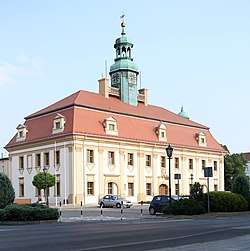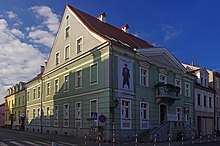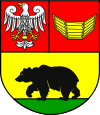Rawicz
Rawicz [ˈravʲit͡ʂ] (German: Rawitsch) is a town in western Poland with 21,398 inhabitants (2004). It is situated in the Greater Poland Voivodeship (since 1999); previously it was in Leszno Voivodeship (1975–1998). It is the capital of Rawicz County.
Rawicz | |
|---|---|
 Town Hall in Rawicz | |
 Coat of arms | |
 Rawicz  Rawicz | |
| Coordinates: 51°36′33″N 16°51′27″E | |
| Country | |
| Voivodeship | |
| County | Rawicz County |
| Gmina | Gmina Rawicz |
| Established | 1638 |
| Town rights | 1638 |
| Government | |
| • Mayor | Grzegorz Kubik |
| Area | |
| • Total | 7.81 km2 (3.02 sq mi) |
| Population (2006) | |
| • Total | 21,301 |
| • Density | 2,700/km2 (7,100/sq mi) |
| Time zone | UTC+1 (CET) |
| • Summer (DST) | UTC+2 (CEST) |
| Postal code | 63-900 |
| Area code(s) | +48 65 |
| Car plates | PRA |
| Website | http://www.rawicz.pl |
History
The town was founded by Adam Olbracht Przyjemski of Rawicz coat of arms for Protestant refugees from Silesia during the Thirty Years' War. In 1638 King Władysław IV Vasa granted Rawicz town rights and confirmed the town's coat of arms.[1] Rawicz was built as a precisely planned town and developed at a rapid pace.[1] It was located on the trade route connecting Poznań and Wrocław.[1] In 1640, a cloth guild was founded.[1] Cloth production became a leading branch of the local industry, and by the end of the 18th century Rawicz was the leading weaving town of the whole region of Greater Poland.[1]

After the destruction of Rawicz by the Swedes in 1655 during the Deluge, the town was rebuilt in an impressive way, erecting new townhouses, a Baroque church and a Catholic monastery.[1] The early 18th century was an unfavorable period in the town's history. In 1701 it suffered a fire, in 1704-1705 it was occupied by Sweden, foreign troops marched through it: Russians in 1707, Austrians in 1719, Saxons in 1733.[1] In the following decades, rapid development took place again, the construction of the castle was completed and a new Baroque town hall was built.[1] In the second half of the 18th century, there were two breweries, a distillery, a slaughterhouse, and a brickyard in Rawicz.[1]
In 1793, Rawicz was annexed by Prussia as a result of the Second Partition of Poland. In 1807 the town was recovered by Poles as part of the short-lived Duchy of Warsaw and in 1815 it was again annexed by Prussia, initially as part of the autonomous Grand Duchy of Poznan.[1] The principal industry was the manufacture of snuff and cigars. Trade involved grain, wool, cattle, hides, and timber. In 1905 it had 11,403 inhabitants.
After World War I Poland regained its independence in 1918. In 1919 the Battle of Rawicz was fought as part of the Greater Poland uprising, aiming to reunite the region with the reestablished Polish state. Rawicz returned to Poland in January 1920. On the first day of the invasion of Poland on September 1, 1939, the Germans entered the town, but were forced to withdraw.[1] They entered again on September 5, and in October they carried out the first executions of Polish residents.[1] In January 1945, the town was taken over by the Soviets, who imprisoned soldiers of the Polish Home Army here.[1] Later on, the Soviet-appointed communists organized a prison here for political opponents, of which 142 died here.[1]
In 1973, Sarnowa was included within the city limits.
A large prison exists in former monastery since 1820.
A 50 billion cubic feet natural gas discovery at Rawicz in 2015 is expected to be the largest gas development in Poland for 20 years.[2]
Sights
Among the historic sights of Rawicz are the Market Square with the Baroque town hall, the Baroque Church of Saint Andrew the Apostle, the Classicist Church of Saint Andrew Bobola, the Gothic Revival Church of Christ the King, the Planty Park and historic townhouses, dating back to the 18th and 19th century.
_ID_655830.jpg) Saint Andrew the Apostle church
Saint Andrew the Apostle church Saint Andrew Bobola church
Saint Andrew Bobola church Church of Christ the King
Church of Christ the King Townhouses at the Market Square
Townhouses at the Market Square
Sports
Speedway club Kolejarz Rawicz is based in the town.
Transport
A railway station is located in the town.
Notable residents
- Heinrich Gottfried Ollendorff (1803–1865), German grammarian and language educator
- Wolfgang Straßmann (1821–1885), politician
- Heinrich Braun (1862–1934), surgeon
- Maximilian Otte (1910–1944), Luftwaffe pilot
- Arthur Ruppin (1876–1943), Zionist
- Reinhard Seiler (1909–1989), Luftwaffe officer
- Piotr Świderski (born 1983), speedway rider
- Anita Włodarczyk (born 1985), hammer thrower
- Karol Świderski (born 1997), football player
See also
- Coat of Arms of Rawicz
References
- "Rys historyczny". Gmina Rawicz (in Polish). Retrieved 4 October 2019.
- http://www.oilvoice.com/n/San_Leon_Energy_announces_halfyear_2015_interim_results/4ce00b439084.aspx
